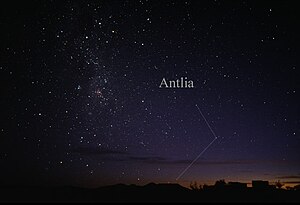Antlia
Antlia or the Pneumatic Pump is a constellation in the southern celestial hemisphere. Its name refers to the device invented by the French physicist Denis Papin in the 17th century. The constellation was introduced by Nicolas-Louis de Lacaille, under the name of Antlia Pneumatica, when he was working at the Cape of Good Hope Observatory and is counted among the eighty-eight modern constellations. Lying close to the stars that made up the ancient constellation Argo Navis, Antlia is fully visible from latitudes further south than 49 degrees north.
Antlia is a faint constellation. Its brightest star is Alpha Antliae, an orange giant perhaps variable, since its apparent magnitude varies between 4.22 and 4.29. Another prominent star is S Antliae, an eclipsing binary system whose components are so close that in the future they will merge to form a single star. Two stars with exoplanets are known in this constellation: HD 93083 and Wasp-66. Notable deep-sky objects are the galaxy NGC 2997 and the Antlia dwarf galaxy.
History
French astronomer Nicolas-Louis de Lacaille first described the constellation between 1751 and 1752 as la Machine Pneumatique (in Spanish, the Pneumatic Pump), commemorating the air pump invented by French physicist Denis Papin. Lacaille had observed and cataloged nearly 10,000 stars in the southern hemisphere during his two-year stay at the Cape of Good Hope, in the process devising fourteen new constellations for the unexplored regions of the southern sky that were not visible from Europe. All but one were named for instruments symbolizing the Enlightenment. Lacaille Latinized the name as Antlia Pneumatica in his 1763 letter. John Hershel later proposed reducing the name to a single word, which was universally accepted.
Although Antlia was technically visible to classical Greek astronomers, its stars were too faint to be included in any ancient constellation. Lacaille depicted Antlia as a single-cylinder vacuum pump, the model used in Papin's early experiments, while Johann Bode chose the more advanced double-cylinder version. The International Astronomical Union (IAU) later adopted it as one of the eighty-eight modern constellations. There is no mythological legend associated with Antlia, as Lacaille discontinued the tradition of giving mythological names to the constellations; instead he chose the most scientific instrument name.
Some of the most prominent stars in the present Antlia constellation may have been included in the ancient constellation of Argo Navis, the ship of the Argonauts, which because of its large size was divided into several smaller constellations by Lacaille in 1763. However, given the faintness of these stars and the darkness of this part of the sky, most researchers do not believe that the ancient Greeks included Antlia as part of the classical description of Argo Navis.
Antlia in Chinese astronomy
Chinese astronomers were able to see the modern Antlia constellation from their latitudes and incorporated its stars into two different constellations. Several stars in the southern part of Antlia were a portion of Dong'ou, while Epsilon, Eta, and Zeta Antliae were included in the celestial temple that also contained stars of modern Pyxis, the Compass.
Description
The Pneumatic Pump ranks 62nd by covering 238.9 square degrees (0.579%) of night sky. Given its position in the southern celestial hemisphere, it is fully visible in latitudes south of 49° N, although parts of the constellation can be seen as far as 65° N. Hydra stretches along its northeastern border while Compass, Sails, and Centaur occupy the western, southern, and eastern borders respectively. The three-letter abbreviation adopted by the International Astronomical Union is "Ant". The official boundaries of the constellation, as established by Belgian astronomer Eugène Delporte in 1930, are bounded by a twelve-sided polygon. In the coordinate system celestial, the right ascensions of these frontiers are between 9 h 26.5 m and 11 h 5.6 m, while the limit declinations are −24.54° and −40.42°.
Main Stars
- α Antliae, spectral-type orange giant K4 and magnitude 4.25. It's the brightest star in the constellation.
- δ Antliae, a binary star of magnitude 5,56; it is accompanied by a star of magnitude 9.7 and both are 1100 light years away from the Sun.
- ε Antliae giant star of type K3III magnitude 4,66; 710 light years near the limit with the Constellation of Pyxis.
- γ Antliae, triple star system that can be solved with small telescopes.
- MIL Antliae, a white star of magnitude 5,24 with a companion of magnitude 11 to half a minute of arc.
- . Antliae, an orange giant of magnitude 4,61, the third brightest star of the constellation.
- S Antliae, contact binary and variable W Ursae Majoris whose brightness ranges between magnitude 6.4 and 6.92.
- U Antliae, carbon star and irregular variable of mean magnitude 5.5.
- AG Antliae, post-AGV star over 2000 light years away.
- DEN 1048-3956, dark red dwarf or brown dwarf located 13,17 light years away.
Notable Deep Sky Objects
- NGC 2997, large and weak spiral galaxy, with a star core. It is very difficult to observe it with a small telescope given its size and intensity.
- Enana de Antlia, elliptical dwarf galaxy, one of the most distant members of the Local Group.
- Cúmulo de Antlia, located between α, η e ι Antliae. It contains approximately 17 NGC objects and 2 IC objects, including the elliptical galaxy NGC 3268, NGC 3258, NGC 3271 — elliptical galaxies both — and NGC 3281, spiral galaxy. NGC 3258 has five other galaxies with the same number: NGC 3258a, NGC 3258b, NGC 3258c, NGC 3258d and NGC 3258e. IC 2587 is another elliptical galaxy.
Contenido relacionado
Cetus
Sirius
Arthur (star)
